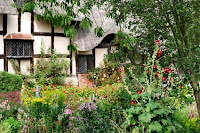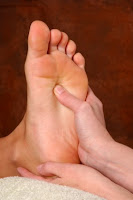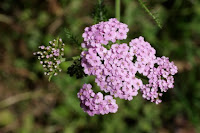
A blog dedicated to promoting the healing power of essential oils and aromatherapy
Wednesday, September 30, 2009
Essential Oils for Women's Health

Monday, September 28, 2009
Properties of Carrier Oils

When deciding to study aromatherapy and essential oils, many people focus on learning all they can about essential oils and what they can be used for. However, although the properties of essential oils are important, it is also important to consider the properities of the carrier in which you are going to put the essential oils.
Carriers for essential oils can include:
- white lotion
- bubble bath
- shampoo
- distilled water
- milk
- honey
- oil.
Perhaps the most important of these is the carrier oil. There are many carrier oils which can be used in aromatherapy for essential oils and many carrier oils carry therapeutic properties of their own, in addition to the properties of essential oils. For example, I make up the following blend for back and neck pain:
- frankincense (Boswelli carteri) essential oil
- lavender (Lavendula angustifolia) essential oil
- roman chamomile (Chamaemelum nobile) essential oil
- apricot kernel (Prunus armeniaca) carrier oil
Apricot kernel carrier oil, in itself, has the ability to be pain-relieving, in addition to the pain-relieving properties in the essential oils used. This is just an example of how carrier oils can enhance the overall synergestic blend of essential oils.
Many carrier oils possess therapeutic properties and many are good for certain types of skins too, making them excellent for use in skin care blends.
Over the coming weeks, I intend to profile a few carrier oils in my article writing and will provide links on Aromatherapy Notes when I do. If there is a particular carrier oil you would like to know more about or see profiled, please let me know either by e-mail or by posting a comment at the end of this post!
For further reading : Using Carrier Oils in Aromatherapy Blends
The Properties of Essential Oils
The Jojoba Plant - one of the more popular carrier oils in the USA
Saturday, September 19, 2009
An essential oil garden....
 Did you know that you could have a myriad of essential oil potentials in your very own garden or yard? Many essential oils come from common plants and flowers in our own gardens, depending on which part of the world we live in.
Did you know that you could have a myriad of essential oil potentials in your very own garden or yard? Many essential oils come from common plants and flowers in our own gardens, depending on which part of the world we live in.Some examples of plants and flowers which you could grow in your back garden and distil in a home made still (something I have yet to try!) include:
- lavender (lavandula angustifolia)
- rose (rosa damascena)
- rosemary (rosmarinus officinalis)
- peppermint (mentha piperita)
- thyme (thymus vulgaris)
- chamomile (chamaemelum nobile)
If you live in a warm climate, it may be possible to grow some of the citrus fruit trees, such as mandarin and lemon, although essential oils extracted from citrus fruit trees are cold expressed and not usually steam distilled.
Aside from the possibility of essential oils, the natural fragrance alone of these many plants and flowers, can be uplifting on a summer's day; as the season changes to fall, it is something to think about for next year...
To read the full article I wrote on essential oils in the garden, read An aromatherapy garden , originally published at Sedona Aromatherapie...
If you are a gardener, you may also be interested in How to use essential oils in the garden, the natural partner for the garden.
If you have any comments on essential oils and gardens let me know by posting a comment below!
Thursday, September 17, 2009
Essential Oils for Pregnancy
 Are essential oils 'safe' for use in pregnancy? And if so, which essential oils can you use? These are questions which are hotly debated by therapists and others around the world.
Are essential oils 'safe' for use in pregnancy? And if so, which essential oils can you use? These are questions which are hotly debated by therapists and others around the world.Often essential oils are not used in pregnancy and are not advised for use in pregnancy due to fear; however, although some essential oils are safe for use in pregnancy, some are most definately not suitable for use in pregnancy. It also comes down to using an essential oil correctly and safely.
Read more on how to use essential oils for pregnancy...
Monday, September 14, 2009
Essential Oils For Allergies

Saturday, September 12, 2009
Aromatherapy Foot Blends

- Lavender (Lavandula angustifolia)
- Peppermint (Mentha piperita)
- Geranium ((Pelargonium graveolens)
- Rosemary (Rosmarinus officinalis)
- Fennel (Foeniculum vulgare)
- Lemon (Citrus limon)
- Roman Chamomile (Chamaemelum nobile).
Essential oils can be blended in carrier oils and creams. Aromatherapy foot blends can be used daily after bathing and showering to relieve tired and sore feet. Its also possible to make uplifting sprays to revive tired feet and treat feet with an aromatherapy foot scrub to get rid of dead skin cells.
When using any essential oil, don't forget to pay attention to any cautions or contra-indicators for your personal condition.
In celebration of world reflexology week, I've just launched an Aromatherapy for Feet Section in the Sedona Aromatherapie web store!
To learn more about reflexology read The Egyptian Influence on Reflexology.
Read World Reflexology Week for more information on world reflexology week.
If you have any questions or comments about reflexology and using aromatherapy please leave me a comment or contact me!
Monday, September 7, 2009
What is an Organic or Wild Crafted Essential Oil?

Its not something I originally gave much thought too as I was taught essential oils should be pure. So a 'pure' essential oil is 'organic' isn't it?
Well, not exactly. Although 'pure' essential oils are 'pure' in the fact that they are 100% obtained from plant material and not synthetically made, it depends on how the original plant is grown and farmed to earn a label of 'pure', 'organic' or 'wild crafted'. 'Pure' essential oils may have actually been treated with pesticides in the farming process and although it is argued that only a miniscule amount (if any) is transferred through the distilling process of an 'pure 'essential oil, it is not an 'organic' or 'wild crafted' essential oil.
An 'organic' essential oil has to meet strict guidelines which ensure the plant material has been grown and farmed organically; this has to meet the growing country's criteria for organic farming. A farmer has to be certified as an organic farmer to be able to produce plants which will distill organic essential oils. Consequently, 'organic' essential oils are usually more expensive than 'pure' essential oils as they are more costly to produce, distill and market.
'Wild crafted' essential oils are obtained from sources of wild crafted plants; this may happen naturally, or can be cultivated, if the plants and farming methods again meet certain critieria.
There may be times when there is overlap between 'pure', 'organic' or 'wild crafted' essential oils; for example, some plants don't need pesticides or fertilizers to produce essential oils and are, by their very nature, naturally 'organic' or 'wild crafted'.
As the essential oil business is often a large, commercialized machine it is, again, important to know who your essential oil supplier is and where they obtain their essential oils from; knowing how their essential oils are distilled, farmed and by what methods in which countries, will make you more knowledgeable about whether your essential oil is 'pure', organic' or 'wildcrafted'.
It has made me re-think too more about what the essential oil actually is that I am buying, in my search for reputable and quality essential oil suppliers in the USA! I think that it is also making me a knowledgeable aromatherapist in the process!
If you have any thoughts or additional comments on pure, organic or wild crafted essential oils please post comment at the end of this post!
Thursday, September 3, 2009
Essential Oils for Skincare
 As discussed in my previous post, Historical Use of Aromatherapy in Skincare, many ancient civilizations, including the ancient Egyptians used plants for cosmetic and skin care needs. It was perhaps not in the form of essential oils as we know them today, but many of the plants and flowers which we use in skin care today were , in fact, used; examples include rose, lavender and myrtle.
As discussed in my previous post, Historical Use of Aromatherapy in Skincare, many ancient civilizations, including the ancient Egyptians used plants for cosmetic and skin care needs. It was perhaps not in the form of essential oils as we know them today, but many of the plants and flowers which we use in skin care today were , in fact, used; examples include rose, lavender and myrtle.Essential oils access the body in a number of ways, including absorption through the skin. That is why it is important to know the chemical components of an essential oil and know what to use it for, as your body will absorb the essential oils applied to it. However, as essential oils are usually recommended for dilution in a carrier oil first, the amount is usually minute, but still effective, meaning knowledge of the particular essential oil you are using is important.
Your skin will react in different ways to an essential oil depending on a number of factors. These include:
- your age
- stress
- exercise
- diet
- lifestyle
- the environment
- health.
Depending on your skin type, here's a few recommendations of essential oils for different types of skin:
- dry skin - dry skin needs moisture; dry skin may be sensitive too so gentle essential oils are recommended such as rose, lavender, roman chamomile, sandalwood and patchouli. Good carrier oils for dry skin include avocado, hazelnut and evening primrose.
- mature skin - to stimulate cell growth and to treat wrinkles, mature skin benefits from the essential oils of frankincense, palmarosa, clary sage, lavender and neroli; borage, wheatgerm and vitamin E bases are good carriers for mature skin.
- oily skin - oily skin results in congestion and spots; the PH balance of oily skin can be re-balanced by using the essential oils of geranium, tea tree, cedarwood and lemon or any other essential oil which has astringent or antiseptic properties. Jojoba and apricot kernel are good carrier oils to use as they are light and easily absorbed.
These are just a few of my suggestions for essential oils for skincare; there are many books on the subject, all with a number of aromatherapy recipes for you to try. The only way to know for sure if a blend is going to work for you is to experiment and try a few different essential oil blends before finding an aromatherapy blend for skincare which truly works for you!
Tuesday, September 1, 2009
Yarrow Essential Oil
 Yarrow is an essential oil which is chemically composed in a similar way to a couple of the chamomile oils. It is said to have gained its latin name, Achillea, from the Greek warrior Achilles.
Yarrow is an essential oil which is chemically composed in a similar way to a couple of the chamomile oils. It is said to have gained its latin name, Achillea, from the Greek warrior Achilles.It has a number of uses and properties in aromatherapy; read Yarrow Essential Oil to learn more....

